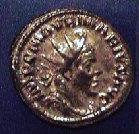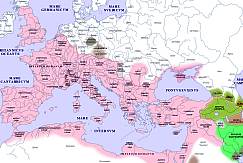Roman Emperors Dir Marius
An Online Encyclopedia of Roman Emperors
Marius (A.D. 269)
Michel Polfer

Marius is the second emperor of the so-called "Gallic Empire". His short reign is to be seen as the consequence of the tumultuous end of the first "Gallic" emperor Postumus, murdered by his own troops for not allowing them to sack Moguntiacum (Mainz), the provincial capital of Germania Superior and former capital of the defeated usurper Laelianus. Immediately after this event, Marius was proclaimed emperor by the soldiers in Moguntiacum.[[1]] The soldiers' choice may have been influenced by his name, MARCUS AURELIUS MARIUS, with its reminder of happier days under the second-century emperor Marcus Aurelius perhaps perceived as a good omen.[[2]].
The year of birth of Marius is not known, but he certainly was of humble origin: according to Eutropius (Eutr. 9.9) Marius was a workman from the lowest class, while Aurelius Victor (Caes. 33.9) indicates that he had been a blacksmith before becoming an active soldier. The literary sources give the impression that he was nothing more than a stopgap army candidate, chosen in the chaos following the murder of Postumus. Obviously Marius was in a very difficult position from the very first days of his reign: he needed to retain the loyalty of Postumus' troops which had brought him to power; he also had to reconcile these forces with the remnants of Laelianus' army.[[3]] His gold and silver coinage accordingly emphasized military harmony (concordia militum) and loyalty (fides militum).[[4]] Moreover, Marius soon had to face the problem of the loyalty of Victorinus, a more obvious candidate for succession to Postumus.
It is very likely that Marius immediately had to permit the troops to plunder Moguntiacum. He then removed himself to Augusta Treverorum (Trier), using the mint there[[5]] and sending Laelianus' former mint back from Moguntiacum to Cologne.[[6]] The literary sources all agree on the fact that Marius reigned only for two days before being killed and replaced by Victorinus. But the coinage of Marius shows that he must have stayed in power for a somewhat longer period, not however exceeding 12 weeks. It was thus around the middle of the year 269 A.D. that he was himself slain,[[7]] apparently for reasons of private revenge.[[8]] After a delay of two days, Victorinus succeeded Marius in Augusta Treverorum (Trier).
Bibliography
1) Primary Sources :
Aurelius Victor, Liber de Caesaribus (33-35), ed. F. Pichlmayr, Leipzig, 1911 (reprinted 1970)
Pseudo-Aurelius Victor, Epitome de Caesaribus (32-35), ed. F. Pichlmayr, Leipzig, 1911 (reprinted 1970)
Eutropius, Breviarium (9.7-9.15), ed. C. Santini, Leipzig, 1979.
Scriptores Historiae Augustae (Tyranni triginta), ed. E. Hohl, Leipzig, 1927.
Zonaras, Annales (12.23-12.27), ed. M. Pinder (Corpus Scriptorum Historiae Byzantinae), Bonn 1844.
Zosimus, Historia Nova (1.29-1.62), ed. L. Mendelssohn, Leipzig, 1887.
Orosius, Historiarum adversus paganos libri VII, ed. C. Zangenmeister, Leipzig, 1889.
John of Antioch, Historica chronica, FHG IV, 1851, 535-562.
Polemius Silvius, Laterculus (45), (Mommsen [ed.], Chron. minor., MGH, AA, 9.1.521).
2) Secondary Sources :
Drinkwater 1987 : J. F. Drinkwater, The Gallic Empire. Separatism and Continuity in the North-Western Provinces of the Roman Empire A.D. 260-274, Stuttgart, 1987 (= Historia Einzelschriften Heft 52).
Chastagnol 1974 : A. Chastagnol, "L empereur gaulois Marius dans l Histoire Auguste," in Bonner Historia Augusta Colloquium 1971, Bonn 1974, 51-58 (=Antiquitas IV,11).
Elmer 1941 : G. Elmer, "Die M nzpr gung der gallischen Kaiser von Postumus bis Tetricus in K ln, Trier und Mailand," in Bonner Jahrb cher 146, 1941, 1-106.
Kienast 1990 : D. Kienast, R mische Kaisertabelle. Grundz ge einer r mischen Kaiserchronologie, Darmstadt, 1990.
Lafaurie 1975 : J. Lafaurie, "L Empire gaulois. Apport de la numismatique," in Aufstieg und Niedergang der R mischen Welt II, 2, Berlin, New York, 1975, 853-1012.
K nig 1981 : I. K nig, Die gallischen Usurpatoren von Postumus bis Tetricus, M nchen 1981.
PIR A 1555.
PLRE 562 Nr. 4.
Schulte 1983 : B. Schulte, Die Goldpr gung der gallischen Kaiser von Postumus bis Tetricus, Aarau, Frankfurt a. M., Salzburg, 1983.
Schulzki 1996 : H.-J. Schulzki, Die Antoninianenpr gung der gallischen Kaiser von Postumus bis Tetricus (AGK) : Typenkatalog der regul ren und nachgepr gten M nzen, Bonn, 1996 ( = Antiquitas 3, 35).
Notes :
[[1]]K nig 1981, 138-139; Drinkwater 1987, 137 and 177.
[[2]]K nig 1981, 137. The Historia Augusta (Tyr. trig. 8.1 and 8.3) give the names Mamurius and Veturius, which are both fictitious: Kienast 1990, 242.
[[3]]Drinkwater 1987, 35 and 177.
[[4]]See the aurei, Elmer 1941, no. 626 and 642.
[[5]]I am here following Drinkwater (1987, 177-178, after Elmer 1941 and Lafaurie 1975), who argues that the sequence of antoniniani from Laelianus to Marius and the eventual transfer of Marius' gold coinage from the secondary mint to the primary Gallic mint suggests that he first ruled from Mainz/Cologne but soon moved to Trier. K nig thinks that Cologne remained the capital of Marius and that Marius' successor Victorinus moved the capital of the "Gallic Empire" to Trier (K nig 1981, 145).
[[6]]Drinkwater 1987, 35 and 146.
[[7]]According to Elmer 1941, it is possible to distinguish two emissions of the Cologne mint and six emissions of the mint in Trier (or Mainz ?). For a discussion of the chronology see Chastagnol 1974, 54 ; K nig 1981, 138 ; Drinkwater 1987, 53 and 178.
Copyright (C), Michel Polfer. This file may be copied on the condition that the entire contents, including the header and this copyright notice, remain intact.
For more detailed geographical information, please use the DIR/ORBAntique and Medieval Atlas below. Click on the appropriate part of the map below to access large area maps.

 DIR Atlas
DIR Atlas